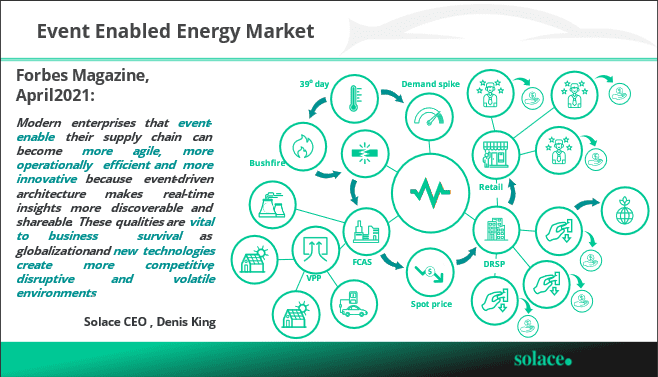The electricity industry is amongst those industries most impacted by the decarbonization imperative, and a very great deal is already being done. I’d like to explain how event-enabling systems with an event mesh can have a positive impact on operational efficiency and help reduce Scope 1 emissions, i.e. those released as a direct result of a company’s own operations.
Some “events” are more important than others when it comes to electricity. Important events can include extraordinary demand situations, a power station being down, or part of the grid becoming “islanded” — all of which can lead to blackouts. There are also little events that, in aggregate, can have a significant impact, like turning off an air conditioner once the worst of the daytime heat is over with, saving money, energy, and emissions.
Seeing things through what I like to call an “events lens” is imperative to understanding how systems and processes can be deployed and optimized by making them event-aware.
The Anatomy of an Event
Before discussing solutions related to the electrical grid, I’ll introduce star of this discussion: the event. An event in this context can be defined as “a significant change in state,” which can also include the passing of a deadline when some event didn’t happen. The occurrence of an event can be publicized to interested parties (systems, applications, people, processes, etc.) by an object, often called an event notification. The notification is accompanied by some data representing the current state. In reality, applications are continuously exchanging events as what we call event streaming.
Events can be created at every level of your system, like a change in temperature, a telemetry stream from plant, a delivery notification from supplier, or a scheduling event from an ERP system. A key difference when considering event processing is that events are independent of consumers. All of the aforementioned examples occur either in the digital or real world irrespective of other system dependencies. To that end, events are published with no knowledge of where the event is to be consumed (in theory). Interested parties register interest via an event broker, which routes the events to where they need to be, in real-time, via the publish/subscribe messaging pattern.
We call this software design pattern in which decoupled applications can asynchronously publish and subscribe to events via an event broker event-driven architecture. When implemented with care, event-driven architecture can enhance system resilience, agility, and scalability. An event mesh is a network of event brokers that enables event communications to be governed, flexible, reliable, and fast.
The Need to Event-Enable the Electrical Grid
Operating the electrical grid is a never-ending balancing act. Traditionally, power systems do not store electricity, so grid operators must ensure that supply and demand (what gets put in by generators versus what gets used by companies and consumers) are in balance in real-time. If they don’t do that, then the “frequency” of the system would move outside the required range. Too little supply coming in from generators to meet demand will cause the frequency to drop, causing the system to become unsafe if it is not addressed in a timely manner.
To make matters more difficult, having generators of electricity that can be fed into the grid quickly, and on very short notice, to address falling frequency is specialist and expensive. When generators deploy their capability to dispatch power to the system quickly to maintain frequency, it is called frequency control. In Australia these specialist suppliers are called frequency control ancillary services (FCAS).
To make all this work, there are complex supply, transmission, and distribution market arrangements and a fluctuating “spot price” for electricity. The spot price tells generators how much electricity the market needs at any moment in time to keep the physical power system in balance. When the spot price is increasing, generators ramp up their output or more expensive (FCAS) generators turn on to sell extra power to the market.
In the section below I outline a (simplified) day in the life of an electrical grid operator through an event lens. In the next paragraph, there are over 20 events taking place — see if you can spot them.
Setting the Stage: A Hot Day, a Fire, and High Demand for Electricity
It is noon on a 39oC day in Australia and there is a spike in consumer demand for electricity as people turn on their air conditioners to cool their homes. The demand spike causes the frequency of the grid to drop, but remains in acceptable, safe range because the grid operator has systems and processes to manage it. It’s also bushfire season, and a sudden change in wind direction causes a fire that was previously under control to flare up again. The fire destroys some important transmission infrastructure that was supplying power to part of the grid, which as a result is no longer available. Due to this event, the system frequency falls further. The grid operator invokes proven processes to bring online new, short-term sources of generation. Additional FCASs come online, allowing the frequency to remain within an acceptable range, but causing the spot price to rise.
Fortunately, many events like the above are already seamlessly managed as a matter of routine by the grid and/or market operator – especially the actions required to keep the system operating safely and efficiently. But future industry innovations and disruptors, not to mention a lot of new consumers, are going to compound these events as we push to transition to a zero-emission electricity industry in the future. In order to manage millions (or billions) of events in real-time, the zero-emission electricity future will need to be event-driven. That is why viewing the current state, and planning for the future state, through an event lens is important to set the infrastructure up for success.
Disruption and Innovation is Coming
Thankfully, due to cost barriers to the newer technologies continuing to fall, more and more of the total base generation capacity is being met by renewable, non-emitting sources such as wind, solar, and hydro. This shift forces industry participants to fit into the technical and market arrangements that exist, requiring coordination with market operators and other supply and demand side participants. But not all the new renewable sources can be dispatched rapidly and reliably, so they may not be suitable for the quick-response requirements of FCAS.
With the disruption and innovation happening in the industry, some of the FCAS supply may come from distributed energy resources (DERs) and virtual power plants (VPPs), which will aggregate connected supply from potentially hundreds of thousands of new energy sources. These will be commercial or domestic solar energy (roof-top) sources as well as potentially battery powered vehicles connected to chargers, but whose owners have a contract to allow the high-capacity vehicle battery to feed back into the grid during peak times when they don’t need their cars. This last pattern is called vehicle to grid (V2G) and has the potential to materially impact both emission volumes and cost of FCAS due to the sheer number of electric vehicles projected to be in operation in the future, even if only a small percentage of vehicles feed back into the grid at any given time. In 2021 the Australian National University estimated that if Australia’s 19 million vehicles were electrified, they would increase Australia’s electricity consumption by one third.
It also said that these electric vehicles would have about the same energy storage capacity as five Snowy 2.0 pumped hydropower schemes – the largest energy storage infrastructure ever conceived of in Australia. If such a resource could also serve as a dispatchable source of variable, renewable energy the reduction of emitting FCAS generation could be substantial. These VPP aggregators of cheaper short-term supply may, in future, significantly reduce the reliance on emitting FCAS generators, reduce spot price increases, and reduce the cost of electricity that consumers pay to retailers.
Another disruptive innovation is a different type of marketplace aggregator emerging in the industry, this time on the demand side. Consider the example outlined above (the hot day with the bush fire) when the grid operator is still looking to keep the grid in the required frequency range. A new type of aggregator called a demand response service provider (DRSP) could be an option for the operator to take advantage of during a high demand period. DRSPs will have infrastructure, systems, and a contract with consumers or industry users who will receive a financial benefit for committing to curtail predicted but discretionary electricity usage during high demand periods. This is part of what is referred to as creating a two-sided energy market.
The beneficial outcome of this innovation will be behavioral change in consumers and industry, resulting in a reduction in electricity demand and a reduction in emissions wherever emitting generation can be reduced or avoided. This change will be enabled by tracking and acting on many types of events affecting the network on both the supply and demand sides. Since DRSPs will allow the frequency balance to be addressed by consumers reducing demand rather than by adding more generation, the dependency on expensive, emitting FCAS supply will be reduced. This will result in less pressure for the spot price to increase, reducing cost to consumers and reducing emissions at the same time.
The Need to Focus on Events
To summarize, the future of electricity demand will be served by new, non-emitting sources of generation and high-demand situations will be addressed more dynamically through demand reduction on the consumer side. Non-emitting (renewable) sources like VPPs and V2G will take the place of expensive, FCAS generation, effectively reducing emissions.
Energy Sector: The Business Case For An Event MeshA look at how IT infrastructure can help lower unit production costs and drive a digital transformation strategy.
To achieve this, there will be a profound increase in the number of active market participants. It will change from a few large generators to millions of distributed and empowered consumers who take from and give back to the grid as their circumstances (and needs) fluctuate. As you may have guessed, this means the number of events that need to be managed in real-time to ensure systems, processes, people, and applications get the information they need to keep the grid operating in an acceptable state can grow to millions or billions per day. These events will need to be analyzed, triaged, and acted on (with capable analytics, AI, and machine learning) every day. An event mesh is the only way to intelligently route and reliably distribute that kind of volume of events to where they need to be so that data can be used as efficiently as possible.
These scenarios are very real and they are coming. In order to be ready for it, the industry needs to shift to be event-focused and start setting their systems, process, and applications up for success by implementing event-driven architecture.
The A to Z of V2G – The ANU, Battery Storage and Grid Integration Program, 2021
Explore other posts from category: Use Cases

 Peter Thomson
Peter Thomson

